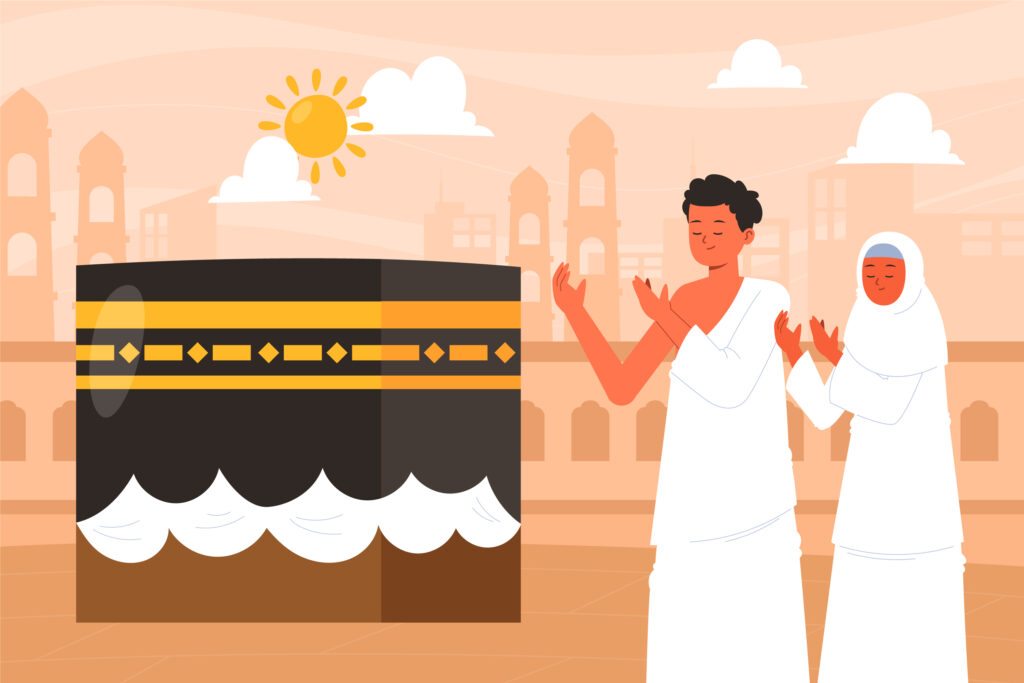Welcome to our guide on the Hajj pilgrimage and the significance of Sa’i Between Safa and Marwa, The Hajj pilgrimage
is one of the most important religious journeys for Muslims, and it involves a series of rituals and acts of worship.
One of these rituals is the running between Safa and Marwa, which holds great historical and spiritual significance.
In this article, we will explore the history of Safa and Marwa, the significance of this ritual in the Islamic faith, and what Muslims say during the pilgrimage. Let’s begin our journey of discovery.
What is Sa’i Between Safa and Marwa?
Safa and Marwa are two small hills located near the Kaaba, These hills hold immense historical and religious significance in the Islamic faith. They are an integral part of the Hajj and Umrah pilgrimage.
The names Safa and Marwa refer to two mountains mentioned in the Qur’an.
Moreover, The hills themselves have undergone changes throughout history, Initially, they were natural hills, but as Mecca developed,
the surrounding area was leveled, and the hills were encased within the current structure of the Masjid al-Haram.
History of Sa’i Between Safa and Marwa
According to Islamic tradition, Hajar, the wife of the prophet Ibrahim, ran between these hills in search of water for her son Ismail.
The story goes that when Ismail was an infant, he became thirsty and Hajar desperately searched for water.
In her despair, she walk back and forth between Safa and Marwa seven times, until finally, a spring known as Zamzam miraculously sprang forth near Ismail’s feet.
As a commemoration of Hajar’s devotion and her unwavering faith in Allah’s providence,
Muslims perform the ritual of running between Safa and Marwa during the Hajj pilgrimage.
The act of walking between Safa and Marwa during the Hajj and Umrah pilgrimage is
a symbolic reenactment of Hajar’s desperate search for water and her unwavering faith in Allah’s providence.
It serves as a reminder of the power of perseverance and trust in Allah’s plan.
The significance of Safa and Marwa extends beyond their historical context, and they represent the resilience and
determination displayed by Hajar and serve as a reminder of the importance of faith and trust in Allah’s guidance.
How Do Muslims Perform The Pilgrimage to Sa’i Between Safa and Marwa?
Firstly, The pilgrimage to Sa’i between Safa and Marwa involves a specific ritual known as Sa’i.
Sa’i is the act of running or walking briskly seven times between the hills of Safa and Marwa, following in the footsteps of Hajar, the wife of the prophet Ibrahim.
Secondly, The ritual of Sa’i is performed as part of the Hajj pilgrimage, which takes place in
the month of Dhul-Hijjah, or during the Umrah pilgrimage, which can be performed at any time of the year.
The Ritual of Walking Between Safa and Marwa
Firstly, Sa’i between Safa and Marwa steps:
- Before starting the ritual, pilgrims should be in the state of Ihram, and completing Tawaf.
- Pilgrims start at the hill of Safa and face the Kaaba.
- They make the intention (Niyyah) for Sa’i and recite the Talbiyah, a supplication praising Allah and expressing their intention to perform the pilgrimage.
- They then climb the hill of Safa and look towards the Kaaba, raising their hands and reciting supplications and prayers.
- From Safa, they descend and start walking briskly toward the hill of Marwa.
- Upon reaching Marwa, they climb the hill and repeat the same supplications and prayers.
- They then descend from Marwa and walk back towards Safa.
- This process is repeated seven times, with pilgrims walking or running briskly between the hills of Safa and Marwa.
Secondly, What to Say During Sa’i Between Safa and Marwa
During each round of Sa’i, pilgrims can recite various supplications and prayers. While there is no specific prescribed prayer
to be recited between Safa and Marwa, pilgrims often engage in personal reflection, seeking forgiveness, and expressing gratitude to Allah.
There are many supplications that can be recited during Sa’i, for example:
- “O Allah, I seek Your forgiveness and I turn to You in repentance.”
- “O Allah, grant me the strength and perseverance to complete this ritual.”
- “O Allah, accept my prayers and supplications.”
- “O Allah, guide me on the straight path and grant me success in this life and the hereafter.”
While reciting these supplications, pilgrims should try to maintain a state of focus and concentration,
reflecting on the significance of the ritual and its connection to the story of Hajar and Ismail.
- Moreover, Completing the Sa’i Ritual
- After completing the seven rounds of Sa’i between Safa and Marwa, the ritual is considered complete.
- Pilgrims then proceed to other rituals and acts of worship as part of the Hajj or Umrah pilgrimage.
- The Sa’i between Safa and Marwa serves as a powerful reminder of the faith, perseverance, and trust in Allah demonstrated by Hajar.
- Key Takeaways
- Sa’i between Safa and Marwa are two small hills near the Kaaba in Mecca, Saudi Arabia.
- The ritual of running between Safa and Marwa commemorates Hajar’s search for water and her trust in Allah’s plan.
- Walking between Safa and Marwa is a unifying experience for Muslims, emphasizing the unity and equality of believers before Allah.
- The ritual of Sa’i involves walking or walking briskly seven times between Safa and Marwa, following in Hajar’s footsteps.
- Completing the Sa’i ritual signifies the completion of the pilgrimage to Safa and Marwa.
In conclusion, By understanding the history, significance, and rituals associated with Safa and Marwa,
Muslims can deepen their connection to the Hajj pilgrimage and draw important lessons about faith, perseverance, and trust in Allah’s plan.






